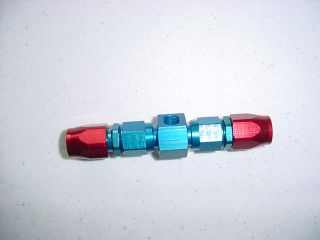
|
FUEL LINE MODS |
|
Overview |
Before I go into what I did, let me start off with some info so you know what I am talking about. The entire fuel line system is made up of a feed line and a return line. Obviously, the feed line brings fuel to the throttle body, and the return line brings unused fuel back to the tank. From the back of the tank, there are hard lines that go from the fuel pump to the driver's side "frame rail" right in front of the brake system's master cylinder. There, they switch to about a foot of rubber lines to allow for the engine to move independent of the car. After those rubber lines, both lines then switch back over to the hard lines, and then go to the throttle body. Before connecting to the throttle body, each goes into a reducer. Here is some info about the thread sizes and types that are used on the stock system:
All threads are metric
Feed line fittings are 16mm x 1.5
Return line fittings are 14mm x 1.5
The reducers take the feed line from 16mm x 1.5 to 14mm x 1.5, and the return line from 14mm x 1.5 to 12mm x 1.25
At each end of the rubber line, there is an O-Ring seal
In the female end of the reducer (at the throttle body) there is an O-Ring seal
On the male end of the reducer (at the throttle body) there is a plastic washer seal
All high performance fuel line systems feature the "Army Navy" threads and fittings. Commonly referred to as the "AN" fittings, these are pretty much the only ones used, so that's what I went with. For fuel lines there are a few different sizes that you can use, but for a TBI car, you usually use "-6AN", which is equivalent to about 3/8" hose.
Click on this thumbnail below to see a larger diagram showing many of the sizes of fittings, threads, etc.
|
Installation Notes |
After I did most of my work to my engine, there was little left over that wasn't touched, except for the fuel lines. I had originally replaced the hard lines running from the rubber lines to the throttle body with regular "fuel injection hose" that you find at Pep Boys, or another one of those places. It didn't look that good and I didn't trust the reliability of it. That is when I decided to go with the stainless steel braided fuel lines. They are much better quality, and offer much greater reliability because of the fittings that they use.
I replaced the hard lines on the engine and the rubber lines. So, now, from the hard lines coming from the back of the car, I have the stainless lines attached which go directly into the throttle body.
At the end of the had lines coming from the back of the car, there is a male metric thread with an O-Ring seal. Here is what one of them looks like:
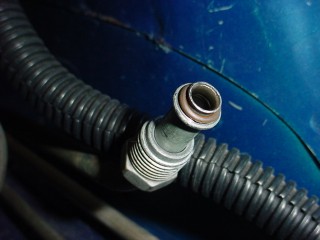
At this point in the fuel lines, you have to convert from the metric thread with the O-Ring to the -6AN thread. This is accomplished by using an adaptor from Earl's which is pictured below:
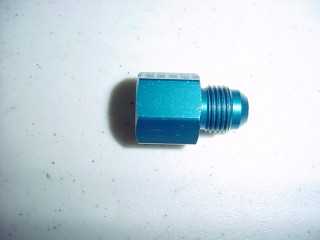
This adaptor takes the 16mm x 1.5 thread on the feed line and the 15mm x 1.5 thread on the return line and turns them both into a -6AN thread. Installed on the hard lines it looks like this:
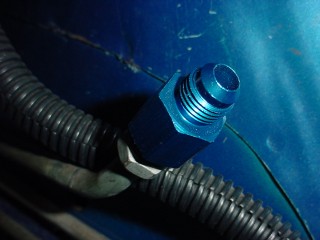
You then use a standard fitting to go from the -6AN thread to the -6AN hose, which is pictured here:
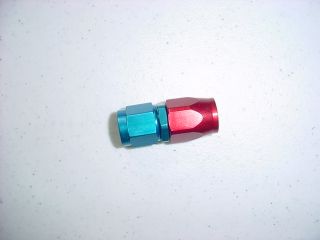
The hose goes into the red end of this fitting, and the blue end screws onto the adaptor above. After getting these hoses attached and the hose routed to the throttle body, I chose to add a fuel pressure gauge. The same fittings above are used, with a special fuel pressure gauge fitting between them:
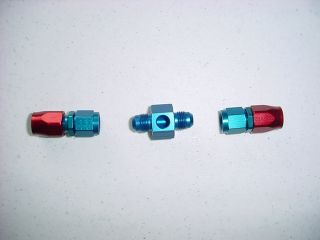
These attach in the same way as the other fittings: the hose goes into the red half, and the blue halves screw onto the fuel pressure fitting. After getting the FPG installed, it was time to hook the fuel lines into the throttle body. As I stated above, there is a reducer in the stock setup that steps the size of the threads going into the throttle body down a little. Here you have a couple options. You can get adaptors that have the smaller male metric threads on one side and a -6AN thread on the other and not use the stock reducers at all. OR, you could get adaptors that has the larger male metric threads on one side and the -6AN threads on the other, and use the stock reducers. The second choice is a little easier because those adaptors are easier to get a hold of. But, the first choice makes for a cleaner installation, but at the same time, the fittings are harder to get and it costs more money.
I chose the first option because I wanted the cleanest installation I could get. Here is a pic of the adaptors that I used:
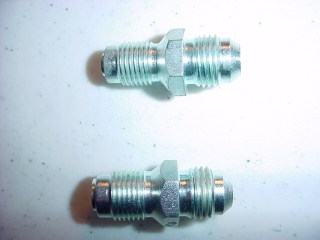
They have the metric side on the left with the washers, and the -6AN side is on the right. These go right into the throttle body and the -6AN fittings can be attached directly to them. Here is a pic of the finished product:
Here is a shot from the driver's side of the FPG:

Driver's side, close-up of the throttle body fittings
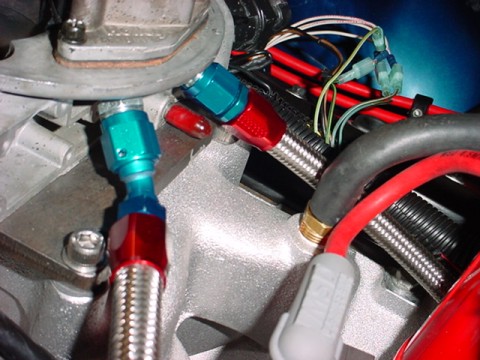
From the passenger's side, you can see that the return line goes around the back behind the distributor.
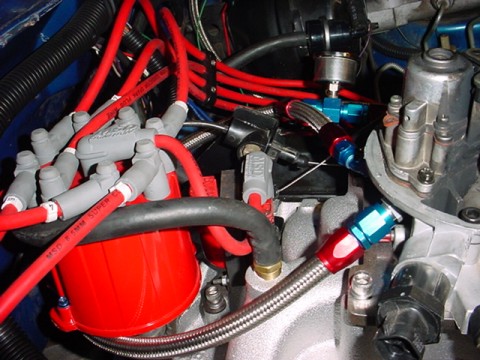
Here is a pic of the whole thing, but you can't see the fittings near the hard lines. They will be coming soon.
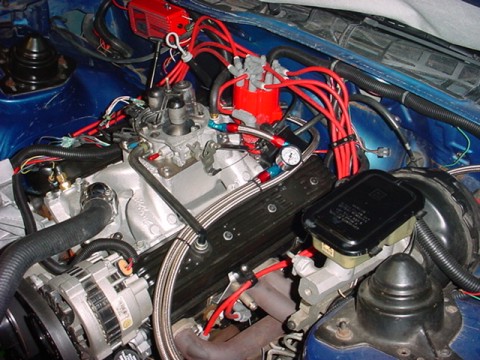
|
Fuel Line Routing |
There were a lot of different ways to route the fuel lines around the engine compartment. I had originally planned to follow the stock routing, but that wasn't possible after I actually tried it. The fittings that I bought didn't work out. The braided line doesn't bend very easily, so you have to try the routing of the lines before you assemble them or you may be in trouble.
I ended up taking the feel line and keeping it in basically the factory location. But, the return line wasn't going to work that way. I routed it around and in back of the distributor. It was the only way to get everything to work out. I purchased the angled fittings planning on doing it one way, but luckily I was able to route them differently and not need different fittings. The return line is just a straight fitting going into the throttle body as you can see below. That picture is taken from the passenger's side, and you can see the fuel line wrap around the distributor and go directly into the throttle body with a straight fitting.

The feed line was another story. Not only was the routing harder because I had to use the angled fittings, but I added a fuel pressure gauge that added a little complexity.
The routing goes like this: From the hard line at the frame rail, there is a length of braided line that ends with a straight fitting. The straight fitting goes directly into the fuel pressure gauge fitting. After the fuel pressure gauge fitting, there is a 120° angled fitting, then a short length of braided line, then a 45° angled fitting that goes into the throttle body. Here is a pic of the fittings:

Here is a pic of the fuel pressure gauge fitting. I took this picture assuming that I was going to use two straight fittings on it, but I only ended up using one straight one and one 120° angled one.

|
Fuel Lines |
|
|
Earl's Auto Flex -6AN Fuel Line |
www.holley.com/HiOctn/ProdLine/Earls.html |
|
Earl's Part #: 310006 (10') |
$51.99 from Jegs |
I chose the Earl's Auto Flex fuel lines because they are high quality, and I have always had good luck with Holley product's. Also, Earl's has a huge selection of fittings, etc. to use with this hose. I ordered a 10' roll of this stuff, but you can probably get away with a 6' roll if you don't make any mistakes.
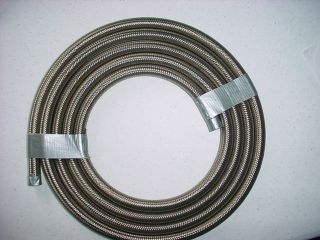
|
Fuel Fittings - Throttle Body "Adaptors" |
|
|
Holley Special Order Fittings |
|
|
Holley part Numbers: 8901558-39 (feed line), 8901559-39 (return line) |
$22.12 (feed line), $9.46 (return line) from Holley |
Like I said earlier, the factory fuel line setup used reducers when terminating the lines into the throttle body. Here is a picture of the reducers:
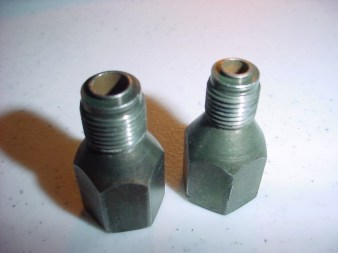
The threads on the factory reducers are metric, and have a weird Teflon washer seal on the male end. If you have ever taken your fuel lines out or unhooked them, you will know what I am talking about. It is a weird clear/whitish looking washer that goes on the tip of the male end of the adaptors. This makes it a pain in the ass to add high performance fuel lines to a TBI car because you cant find an adaptor for this weird application.
The reducers also have an O-Ring seal that goes into the female end. This is the same seal that is on the rest of the fuel lines from the factory. I think that most people just use an adaptor to go from the metric thread with the O-Ring to the -6AN threads and use the existing factory reducers. That isn't as clean as an installation so I tried something else.
I knew there had to be a way around it, so I called Holley one day and after a lot of talking, they ended up sending me the fittings you see below:
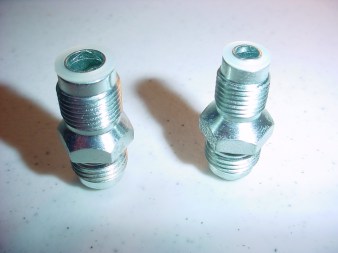

They go into the throttle body in place of the factory reducers. They have the one weird end with the washer, and the other end has a -6AN thread that can be hooked up to just about any high performance fitting around. They were expensive, but they do the job beautifully.
|
Fuel Fittings - Hard Line Adaptors
|
|
|
Earl's Swivel Fuel Injection Adaptors
|
www.holley.com/HiOctn/ProdLine/Earls.html
|
|
Earls Part Number: 9894DBH (Return Line), 9894DBJ (Feed Line)
|
$7.69 each from Jegs
|
This is the adaptor that goes from the hard lines near the master cylinder to the -6AN fittings.

|
Fuel Line Fittings
|
|
|
Earl's Swivel Seal Fittings |
|
|
Earls Part Number: 800106 (straight fitting), 804606 (45° fitting), 812006 (120° fitting) |
$5.99 (straight), $15.99 (45°), $18.99 (120°) from Jegs |
Here are all of the fittings that attach to the braided fuel line hoses.

Straight Fitting
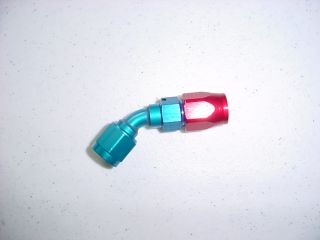
45° Fitting
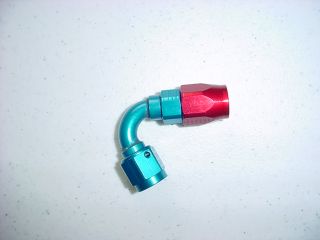
120°
|
Fuel Pressure Gauge |
|
|
Summit Racing Equipment 30 psi F.P.G. |
www.summitracing.com |
|
Summit Part Number: SUM-800130 |
$17.95 from Summit |
One of the most important parts of tuning a TBI car is the fuel pressure. There is no way to tell the FP without a gauge, so I plumbed one into my fuel lines. I got a Summit gauge because it was pretty cheap.

|
Fuel Pressure Gauge Fitting |
|
|
Earl's Inline Fuel Pressure Gauge Fitting |
|
|
Earl's Part Number: 100192 |
$8.69 from Jegs |
I added a fuel pressure gauge to my fuel system because fuel pressure is a very important aspect of tuning a TBI car. The fitting itself has -6AN threads on each side.

